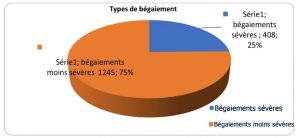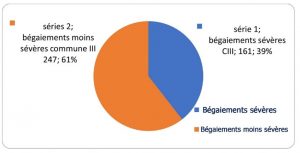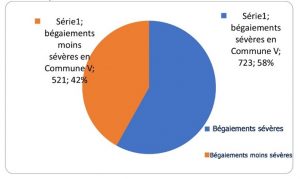|
My name is Zan Camara and I am 43 years old. I started to stutter since my childhood. I am currently the vice president of the Association Vaincre le Bégaiement au Mali. In the past I participated in the congress of IFA in Tour and the ISA World Congress in the Netherlands. I am also a member of a leadership group for the organization of a third African conference on stuttering in Africa. Academically and professionally, I studied Management at the University of Bamako. Currently, I work in an NGO in Mali. |
The association Overcome Stuttering is the only association in Mali that deals with stuttering in Mali. It has been carrying out awareness activities with children and students who stutter for about ten years. There is no statistical data for stuttering. This is why we applied for, and obtained funding from the European Union to conduct a study to identify people who stutter in nursery and basic schools, in order to bring about a change in mentality and behavior for a better management of stuttering. This study could influence the authorities of the country and other decision makers to accompany us for a better management of stuttering, and bring a change of behavior and mentality towards people affected by stuttering.
STUDY ON STUTTERING IN 60 BASIC SCHOOLS AND 11 KINDERGARTENS IN THE COMMUNES III AND V OF THE DISTRICT OF BAMAKO
CONTENTS
INTRODUCTION
- REMINDER OF THE OBJECTIVES AND EXPECTED RESULTS
- METHODOLOGY
- THE IMPORTANCE OF STUTTERING AT THE SCHOOL LEVEL
- PROBLEMS ENCOUNTERED BY STUTTERERS
- LEVEL OF CONSIDERATION OF STUTTERING AS A HANDICAP BY AUTHORITIES
CONCLUSION AND RECOMMENDATION
INTRODUCTION
Stuttering is generally perceived as a speech disorder characterized by repetitions of syllables, prolongations of the simple area to the sentence, silent or plausible blocks or pauses and or other speech anomalies. Stuttering affects the whole person, it is a combination of speech, behavior and communication disorder.
This disability, which is little considered as such by many people, is present in many families and silently rots the existence of many people.
Faced with this situation of generalized neglect, people who stutter have organized themselves into an association called: Association Vaincre le Bégaiement (AVB). This association militates for a better management of stuttering and language and communication disorders in order to ensure a harmonious development of any person affected by this handicap. In this context, the AVB has received funding from PAOSC II in order to understand the burden of stuttering in the communes III and V of the District of Bamako in the school environment.
- REMINDER OF THE OBJECTIVES AND EXPECTED RESULTS
1.1 Global objective :
To improve the living conditions of people who stutter in Communes III and V of the district of Bamako.
- Specific objectives :
- To have an idea of the number of students who stutter in the basic schools and kindergartens of C III and V of the District of Bamako.
- To identify the different types of stuttering according to their severity
- Identify the difficulties that students face in schools.
- Collect the different concerns of teachers and early childhood supervisors through recommendations.
- To have a database on pupils who stutter in the said communes of the District of Bamako through a study report.
1.2 Expected results :
- The AVB has a database on students who stutter in Communes III and V of the District of Bamako.
- The different types of stuttering are identified and classified by commune
- The difficulties that students who stutter and teachers face on a daily basis are known.
- The recommendations of teachers and kindergarten instructors are known.
- A study report is available.
- METHODOLOGY
To achieve the objectives of this study, the following phases were necessary:
2.2. The preparatory phase of the mission
This phase of the study involved a few important steps.
2.2.1. Meeting to understand the mandate
At this stage, the consultant proceeded with a review of the Terms of Reference with the members of the association in order to better exchange on the scope of the study and all the issues at stake. This step allowed the two parties to harmonize their points of view with regard to the various concepts, both in terms of objectives and expected results.
2.2.2. Document review
This consisted of using all available documents related to the mission.
2.2.3. Design and validation of collection tools
The collection tools used were questionnaires : one for the basic schools and one for the kindergartens.
2.3. The data collection phase
2.3.1. Sampling
This was done in close collaboration with the association. Data collection was done in 11 kindergartens and 60 basic schools (including school groups), which is equivalent to 120 schools.
2.3.2. Information gathering activities
Information was collected in basic schools and kindergartens through individual interviews and discussions with teachers.
2.4. The data processing phase
Data processing was done after the information was collected.
2.5. Production of reports
The data processing resulted in the production of the report.
- THE IMPORTANCE OF BEHAVIOR AT SCHOOL LEVEL
3.2. At the basic school and garden level
|
Designations Basic schools |
Number of schools surveyed |
number of stutterers |
Stuttering total |
Percentage (%)
|
|
|
Boys |
Girls |
||||
|
54039 |
1100 |
537 |
1637 |
3,03 |
|
|
kindergartens |
1163 |
12 |
4 |
16 |
1,37 |
|
TOTAL |
55 202 |
1112 |
541 |
1653 |
2,99 |
The surveys showed that among the 55,202 pupils in the 60 basic schools and 11 kindergartens surveyed, there are 1,653 stutterers, of whom 1,112 are boys and 541 are girls, i.e. a rate of 2.99%.
However, at the level of basic schools, there are 1637 stutterers, i.e. a rate of 3.03% of stutterers, the majority of whom are boys and 0.99% girls.
In kindergartens, the rate is 1.37%, the majority of which are boys (1.03) and not girls (0.34).
3.3. Types of stuttering in schools
At the level of schools, the study showed that the two types of stuttering exist at the level of the two municipalities. The two types are: severe stuttering and less severe stuttering. The study showed that 25% of stuttering is severe and 75% is less severe.

3.4. Distribution by commune
a) In commune III
In commune III 39% of stuttering is severe and 61% of stuttering is less severe. This analysis is made on 31358 students. This situation could worsen with population growth.

b) In commune V
In commune V 42% of the stutterers are severe and against 58% of less severe stutterers. This analysis is made on 22.681 students.

- PROBLEMS ENCOUNTERED BY PEOPLE WHO STUTTER
People who stutter encounter several problems at both the school and community levels.
– At the school level
Stuttering is part of the reason why most children who stutter fail in school. Students who stutter have difficulty actively participating in class by speaking up like their peers. They are often ashamed to speak and are teased by their peers. Stuttering leads to feelings of shame, humiliation, isolation, mockery and suffering on a daily basis. This situation forces many children to drop out of school.
– At the social level
People who suffer from stuttering experience enormous difficulties in social, professional and economic integration. People who stutter face daily negative attitudes from people in the community in which they live. In addition, parents rarely display positive attitudes toward these children. Peers provoke them and make them extremely nervous.
In general, people who stutter are not included in their disability.
- LEVEL OF CONSIDERATION OF STUTTERING AS A DISABILITY BY THE AUTHORITIES
Stuttering is not considered a disability by families and local authorities alike. This lack of knowledge means that few people are interested in this disorder. None of the two town halls, no academy takes into account this handicap. Only the Association Vaincre le Bégaiement (Overcoming Stuttering) fights to advance the debate on the possibility of taking into account the concerns of people who stutter in the national development program in general and specifically in the PDSEC of the communes III and V of the district of Bamako like other disabled people. And also in the development programs and projects of technical and financial partners.
CONCLUSION AND RECOMMENDATION
Stuttering is very present in our communities. Among the many disabilities that exist, stuttering is the least known and the least taken care of. Its management is difficult because there are very few speech therapists, only 3 graduates of the school of auxiliaries of Togo on the whole territory.
The study showed that 2.99% of the students surveyed are stutterers and that 25% of stutterers are severe cases. This situation could worsen with demographics. Stuttering is not taken into account by the education services nor by the authorities. It has a negative impact on children’s schooling and on their daily lives. Teachers do not know how to deal with a student who stutters. Parents do not know where to turn and even if they do, few can afford the services of a speech therapist.
To improve the situation of people who stutter and alleviate their suffering, the study recommends
That parents and the whole community be sensitized so that they consider stuttering as a social handicap and as a public health priority :
- That this study be conducted in all the communes of the district and in all the regions of Mali.
- The creation of a speech therapy center for stuttering equipped with qualified personnel in the district of Bamako and in each region following the example of the blind and deaf and AMALDEME.
- The consideration of stuttering and other language disorders in the programs and projects of technical and financial partners.
- Providing AVB with adequate means to ensure prevention and early intervention whose effectiveness is recognized through the support of the authorities and technical and financial partners.
- To sensitize children to overcome or accept their disability;
- Encourage the authorities to create a support framework for children who stutter;
- Assigning speech therapists to associations working in the field of language disorders.
- Qualifying and continuing education for speech therapists specializing in stuttering.
- Increased training of teachers on the handicap of stuttering (how to deal with a student who stutters).
- Referring children who stutter to the rehabilitation sessions organized by Association overcome stuttering in Mali (AVB Mali)
This study was funded by the European Union through the Civil Society Organizations Support Program
![]()

 About the Author:
About the Author:
I welcome all the visitors
Hi Zan,
It’s concerning to hear that PWS are not being supported in this community. The data collected in the study further emphasizes the high demand for clinicians and the urgency for the medicalization of stuttering. PWS deserve to feel supported throughout their childhood to help them manage and have an improved quality of life. Change is necessary.
Zaydell
Hi Zaydell;
In general in Africa and in particular in Mali the management of stuttering is not developed. We are conducting awareness activities with the authorities to take stuttering into account in development programs or policies.
Hi Zan,
I want to first thank you for sharing the research and taking the time to talk to us about this issue with basic schools and kindergarten having no support from the community.The data collected in the study show how urgent clinicians are needed. I also agree with the idea that change is necessary in order to allow for children to feel supported and help manage their life.
Hi Zan! Thank you for all the work you do for stuttering awareness and acceptance. This data highlights that change is needed! I think if a study like this was conducted in other countries, we would see very similar results. Change is needed worldwide! Your findings showing that stuttering has a negative impact on children’s schooling and potentially leads to failing or dropping out is VERY sad to hear. I saw in a previous comment you mentioning awareness activities, what kind of awareness activities are you conducting?
Wow, Zan. What you’re doing to raise awareness i Africa is so important, as the struggle is real! I’m lucky to live in a country where stuttering is accepted, and treates, although there’s still a lot more to wish for. But in countries like yours, so much more is needed. And you’re doing an amazing job! If there is a way for me to help, to f ex videochat with teachers and classes about stuttering, I’d be willing to do so.
Keep them talking
Anita